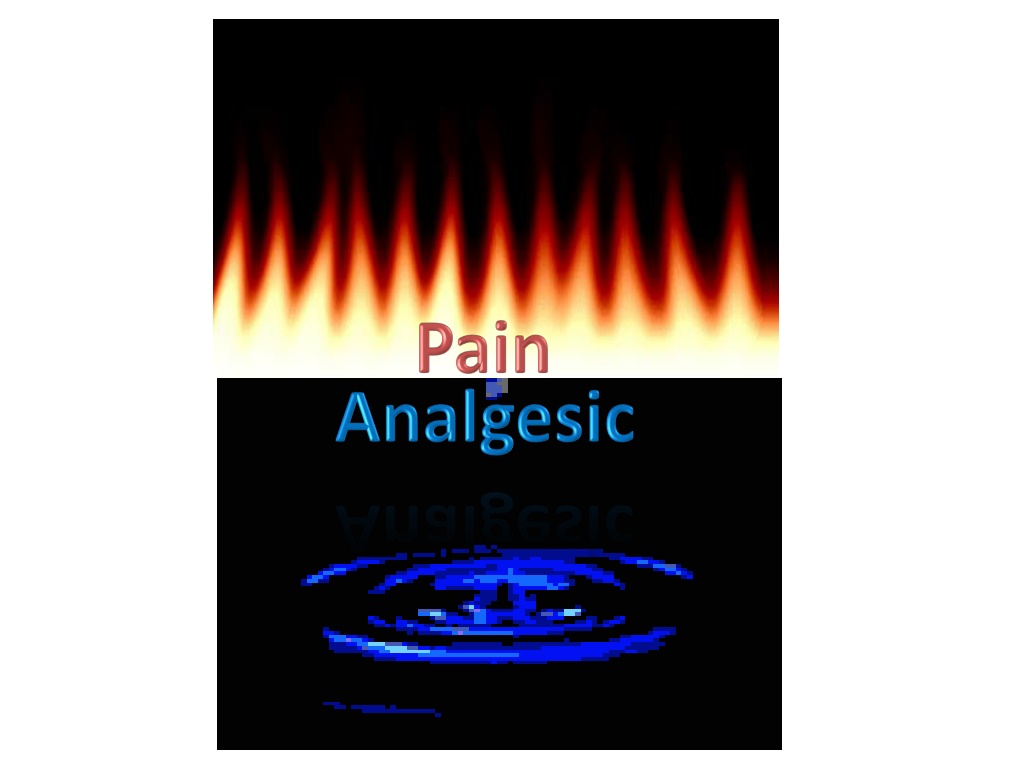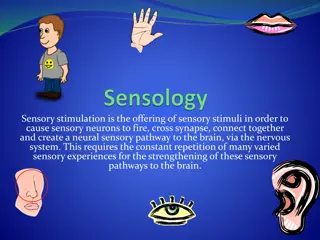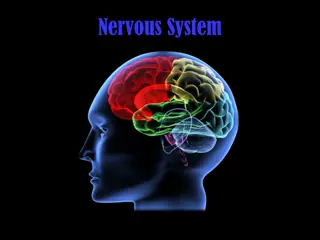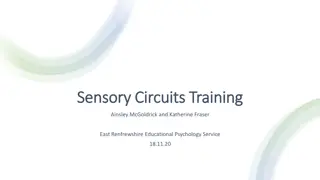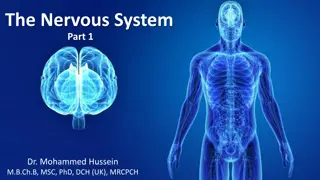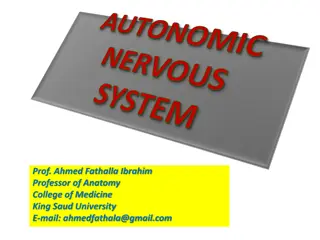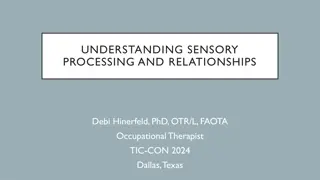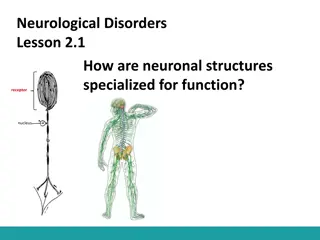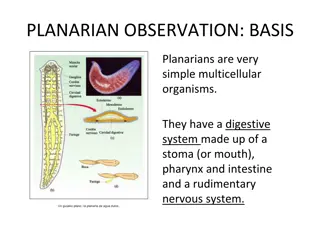Understanding the Nervous System and Sensory Neurons
The nervous system plays a crucial role in connecting the central nervous system (CNS) to limbs and organs through the peripheral nervous system (PNS). It consists of sensory neurons that transmit impulses from sensory receptors to the CNS, allowing us to perceive and respond to various stimuli. The different types of fibers, such as A and C fibers, contribute to the sensation of pain, with each type having distinct characteristics. Nociceptors, pain receptors, are activated by chemical, thermal, or mechanical stimuli, leading to the perception of pain. Understanding nociception and the role of nociceptors in transmitting pain signals can help in developing effective pain management strategies.
Download Presentation

Please find below an Image/Link to download the presentation.
The content on the website is provided AS IS for your information and personal use only. It may not be sold, licensed, or shared on other websites without obtaining consent from the author. Download presentation by click this link. If you encounter any issues during the download, it is possible that the publisher has removed the file from their server.
E N D
Presentation Transcript
LAB # 3 Lab #3
smooth muscle, cardiac muscle, and glands Consists : A- nerves B- ganglia The main function is to connect CNS to the limbs and organs. Outside of the CNS The Nervous System CNS PNS From CNS to PNS Sensory division (afferent) Motor division (efferent) Brain Spinal cord From PNS to CNS Somatic nervous system (voluntary) Autonomic nervous system (involuntary) Sympathetic Parasympathetic Skeletal muscle
Sensory or afferent neurons Neurons carrying impulses (AP) from sensory receptor (at PNS) to the CNS Cell body Unipolar neuron carrying impulses AP Spinal cord
Sensory or Afferent Type A fibers C fibers When an injury occurs, one first senses sharp fastpain (A fibers) before felling the dull slowpain ( C fiber) Myelinated Non- myelinated High conduction velocity Low conducting velocity Cause a sharp and localized pain Cause a dull burning and non-localized pain Pain receptor (Nociceptors) are cells nerve ending that initiate the sensation of pain Sensory Receptor Can be activated by : I. Chemical stimuli II. Thermal stimuli III. Mechanical stimuli This process, called nociception Noxious Stimuli An actually or potentially tissue damaging event
cell membrane phospholipids phospholipases A2 Arachidonic acid COX-2 Noxious Stimuli Prostaglandin E2 (PGE2) Sensitizes nociceptors to bradykinin (BK) , ((the most potent pain producing chemical)) and other pain mediators like substance P histamine, 5-HT etc. Release of endogenous opioid peptide ( endorphin) which cause inhibiting of nociceptive impulse( Modulation ) - For stimulation nociceptors, and lead to production of AP Then transmission the impulse to spinal cord and cortex (perception)
Pain An unpleasant sensory and emotional experience associated with actual or potential tissue damage, or described in terms of such damage Quick sharp pain Slow pain General Specific area Sensation Localization pain Source Duration Somatic Visceral Referred pain Chronic Acute
Without Pain Pain killer Analgesics Are medicines or drugs that relieve pain (analgesia). Analgesic Opioid agent They reduce moderate to severe pain without loss of consciousness. Non-opioid agent Other agent e.g. Acetaminophen Local anesthetics NSAID They reduce mild to moderate pain
Opioid Analgesics Contains many alkaloids morphine Opium Opiate : A drug derived from alkaloids of the opium Interaction with opioid receptor Opioid : the class of drugs that includes opiate, and all synthetic and semisynthetic drugs that mimic the action of opiate Antagonists e.g. Naloxone Mixed agonist- antagonists e.g. nalbuphine Agonists Strong: morphine Moderate : codeine weak: propoxyphene
opioid receptor - It s G protein-coupled receptor. - Mainly located in brain and spinal cord , and may be on peripheral sensory nerve endings - Three types 1- (mu) Most of the analgesic opioids are -receptor agonists Responsible for some major unwanted effects (e.g. respiratory depression, euphoria, sedation and dependence) 2- (kappa) 3- (delta) MOA 1- they close voltage-gated Ca+2 channels on presynaptic nerve terminal thereby reduce transmitter release. 2- they hyperpolarize and thus inhibit postsynaptic neuron by opening K+ channel.
Close voltage-gated Ca+2 channels opening K+ channel reduce transmitter release hyperpolarization
Non Opioid Analgesics Non- Steroidal Anti-Inflammatory Drugs Arachidonic acid NSAID COX-1 COX-2 - NSAID - Thromboxane Prostacyclin Prostaglandins
Cox-2 selective inhibitor (coxib) Cox non-selective inhibitors Example : - Aspirin, - Ibuprofen, - Diclofenac etc Example - Celecoxib Thrombosis GI ulcer
LAB WORK Objective : To show the analgesic effects of different analgesics using different methods. I. II. Hot plate method. Writhing test.
Writhing test Principle: Pain is induced by injection of noxious chemical as Acetic acid 0.1% at volume 0.3 ml. Writhing means stretching behavior of the abdominal and at least one hind limb.
Procedure: 1.First inject the mouse with acetic acid and calculate the number of writhing/20 minutes and this will be control test. 2.Inject the second animal with aspirin and inject the third one with morphine. 3.After 5 minutes inject the animals with acetic acid then calculate the number of writhing/20 minutes.
Control mouse Inj. Morphine Inj. Aspirin Inj. Acetic acid Wait 5 minutes calculate the number of writhing/20 minutes Inj. Acetic acid Inj. Acetic acid calculate the number of writhing/20 minutes calculate the number of writhing/20 minutes
No. of writhing/20 minutes Drug Control Acetic cid Test 1 Morphine acetic acid 5 min s 5 min s Test 2 Aspirin acetic acid
Procedure: 4.Compare the number of writhing for each drug and comment on the results: A drug has number of writhing that has more potency as analgesic. A) Less B) More
Hot plate method principle: The paws of the mouse are very sensitive to heat at temperature which are not damaging the skin . At temperature of 55 C the mouse will jump and licking the paws. The time till these response occur is calculated and is prolonged after administration of analgesics. Hot Plate Analgesia Meter
Procedure: 1. Put the mouse on the hot plate and record the time taken in order to jump or licking the fore paws. 2. Record the time in seconds this is the control time. 3. Weight the animal and calculate the dose of Morphine and Aspirin 4. At 5 min s interval ( for 30 min s ) place the animal on the hot plate and record the time to see the response . 5. Compare the time need to see the response the drug with longer time is more potent as analgesic.
Time interval 15 Drug zero 5 10 20 25 30 Morphine aspirin
Dose mg/Kg Conc (g%) Morphine 0.2% 20 aspirin 3% 300
